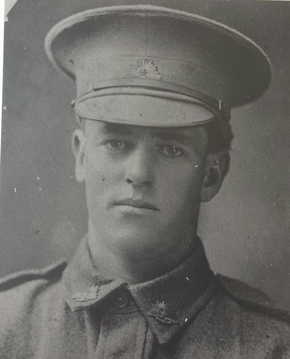HARRINGTON, Harry Richard
| Service Numbers: | 3343, R3343 |
|---|---|
| Enlisted: | 22 July 1915 |
| Last Rank: | Private |
| Last Unit: | 10th Infantry Battalion |
| Born: | Pyap, South Australia, Australia, 4 April 1899 |
| Home Town: | Moorook, Loxton Waikerie, South Australia |
| Schooling: | Kingston-On-Murray Primary School, South Australia, Australia |
| Occupation: | Labourer |
| Died: | Adelaide, South Australia, Australia, 14 August 1945, aged 46 years, cause of death not yet discovered |
| Cemetery: |
West Terrace Cemetery (AIF Section) Kendrew Oval |
| Memorials: | Loxton and District Great War Roll of Honor, Moorook Hundred of Moorook WW1 Roll of Honour |
World War 1 Service
| 22 Jul 1915: | Enlisted AIF WW1, Private, 3343, 10th Infantry Battalion | |
|---|---|---|
| 27 Oct 1915: | Embarked AIF WW1, Private, 3343, 10th Infantry Battalion, HMAT Benalla, Adelaide | |
| 23 Oct 1916: | Embarked AIF WW1, Private, R3343, 10th Infantry Battalion, HMAT Port Melbourne, Adelaide | |
| 4 Feb 1918: | Wounded AIF WW1, Private, 3343, 10th Infantry Battalion, Third wounded in action. GSW Head (severe) | |
| 28 Jun 1918: | Discharged AIF WW1, Private, 3343, Keswick, SA. Total and permanent invalided. |
Help us honour Harry Richard Harrington's service by contributing information, stories, and images so that they can be preserved for future generations.
Add my storyBiography contributed by Schools Program
Harry Richard Harrington was born 4th of April 1899 to John and Mary Ann Harrington of Pyap, South Australia. One of a large family, Harry had eight brothers and sisters. As a child, Harry and his brother Roy, two years his senior, attended school together. They generously donated a penny each to the Kind Edward Memorial in 1910. This generosity of spirit would continue throughout Harry’s life.
Enlisting in 1915 shortly after his 18th birthday, Harry began training locally in South Australia. This birthday may be incorrect and it is more likely that Harry was 16-17 years of age. His parents signed a consent for his enlistment. Harry attended the Musketry Schools at Cheltenham and was promoted to Sergeant on the 24th of July 1916. He would then be put back to Private, before being provisionally re-promoted to Sergeant after officially attending the N.C.O. School. However, on final assignment to the 10th Infantry Battalion, his rank was placed at Provisional/Acting Corporal.
After embarkation in 1916, Harry contracted Typhoid Fever (Enteric) and Thrombosis and was admitted to hospital in Cairo. This forced his return to Australia. On the 21st of October 1916, Harry has re-embarked for overseas, destined for England.
Upon his arrival, Harry fell ill again and was sent to Parkhouse Hospital suffering from Mumps. This lasted approximately four months until Harry finally proceeded to France on the 5th of April 1917. Harry was Taken on Strength to the 21st Battalion from the 10th Infantry Battalion on the 10th of April 1917. His rank was reverted to Private.
After some time in France, Harry was wounded in action on the 7th of October 1917. The wound is not noted and may not have been too severe as he re-joined his unit within three weeks. Harry then fell ill once more and was admitted to the Ships Hospital on the 1st of December 1917. It was a short illness, lasting only 24/48 hours.
On the 7th of January 1918, Harry was wounded again. Nothing noted. Finally, for a third time, Harry was wounded. This time, it was deathly serious. In February 1918, Harry sustained a Gun Shot Wound (G.S.W.) to the head and transited through the 14th General Hospital in Boulogne France on the 4th of February 1918. His mother was sent a telegram, warning that his condition was ‘dangerous’. On the 13th of February, Harry was rushed off the field of battle and to England, where he embarked on the HMHS Cambria. The notes state – ‘GSW Head (Frac Skull)’.
The notes from the hospital paint a bleak picture of the severity of the wounds:
‘Wounded 7-1-18 over right-frontal region entry over left eyebrow.
Large cerebral hernia. Incontinence of urine. Rt eye excised’
By April 1918, the doctors had determined that the orbital wall of Harry’s right eye just needed to be fixed after his eye had been removed. His left eye could no longer see after it was found the retina was injured. Harry had ‘no perception of light’ and was now officially blind.
Harry, unable to recover from the severity of this wound in England, was placed on a ship bound for Australia (HMAT/HS Wandilla). He arrived at the General Hospital, Keswick by June 1918. The medical board deemed Harry to be ‘Incapacitated. Total permanently’. Date of discharge was the 28th of June 1918.
This news was difficult for the Harrington family to take. Harry’s mother wrote to the Keswick Hospital on the 2nd of July 1918 and asked, ‘if there is any hope at all of him regaining it [his eyesight]’. Unfortunately, Harry’s eyesight would never return.
After recovering and being discharged from hospital, Harry became an active member of the Blind Soldiers' Association. Harry and his family would go on to visit the Riverland almost yearly, holidaying with locals, friends, and family. At some point, Harry married and moved to Clarence Park during the 1930’s.
Harry’s life was never dull – working to encourage other blind soldiers to be a part of the community, fundraising for the Comforts Fund, even meeting the Duke and Duchess of York (the later King George VI and Queen Mother) and the Earl of Cavan.
In 1945, at the age of 47, Harry would pass away after spending time, once again, in the Keswick Repatriation Hospital. Although the cause is unknown, it may be presumed that it was related to war injuries as he was in the care of the Army at the time. Harry is buried in the AIF Cemetery, West Terrace Cemetery, Adelaide.













